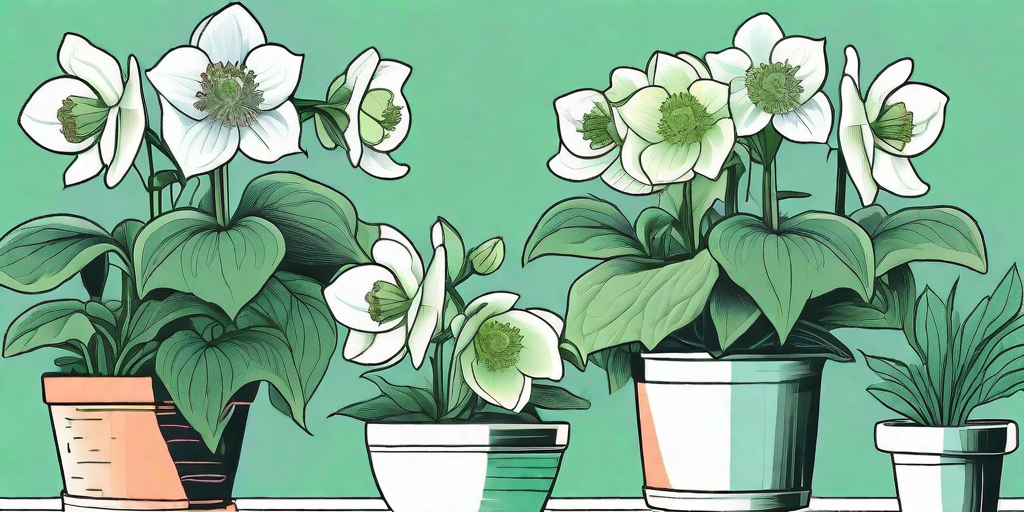
Ah, the hellebore, a plant that's as fun to grow as it is to say. This hardy perennial is known for its ability to bloom in the coldest of winters, bringing a splash of color to your garden when everything else is dormant. But did you know that hellebores can also be successfully grown in pots? Yes, you heard it right! This is a blooming success story about growing hellebores in pots. So, let's dig in, shall we?
Why Hellebores in Pots?
Before we get into the nitty-gritty of how to grow hellebores in pots, let's first address the question that's probably on your mind: "Why would I want to grow hellebores in pots in the first place?" Well, there are several compelling reasons.
Firstly, growing hellebores in pots allows you to control the growing conditions more precisely. Hellebores prefer well-drained soil, and growing them in pots allows you to ensure that they have the perfect soil conditions. Secondly, growing hellebores in pots makes it easier to protect them from pests and diseases. And finally, pots provide the flexibility to move your hellebores around to find their perfect spot in your garden or balcony.
How to Grow Hellebores in Pots
Now that we've established why you might want to grow hellebores in pots, let's get into the how. Fear not, dear reader, for this is a journey we will embark on together.
Choosing the Right Pot
The first step in your hellebore pot-growing journey is to choose the right pot. Hellebores aren't too picky, but they do prefer a pot that's at least 12 inches in diameter and has good drainage. A pot that's too small will cramp the hellebore's style (and by style, we mean roots).
As for material, hellebores aren't fussy. You can choose from terracotta, ceramic, plastic, or even a stylish metal pot. Just make sure it has drainage holes to prevent waterlogging.
Preparing the Pot
Once you've chosen your pot, it's time to prepare it for your hellebore. This involves filling it with a good-quality potting mix. Hellebores prefer a soil that's rich in organic matter and well-draining, so look for a potting mix that fits this description.
Fill the pot to about an inch below the rim to leave room for watering. If you're feeling particularly adventurous, you can also add a layer of gravel or small stones at the bottom of the pot to improve drainage.
Planting the Hellebore
Now comes the fun part: planting the hellebore. Dig a hole in the potting mix that's deep enough to accommodate the hellebore's root ball. Place the hellebore in the hole, making sure that the top of the root ball is level with the soil surface.
Backfill the hole with potting mix, firming it gently around the base of the hellebore. Water thoroughly, and voila! You've just planted a hellebore in a pot.
Caring for Potted Hellebores
Now that you've planted your hellebore, it's time to learn how to care for it. Potted hellebores require a bit more attention than their ground-dwelling counterparts, but with a little love and care, they'll reward you with beautiful blooms.
Watering
Hellebores like their soil to be moist but not waterlogged. In the growing season, this usually means watering once or twice a week. In the winter, you can reduce watering to once every two weeks or so.
Remember, the golden rule of watering is to check the soil first. If it's dry to the touch, it's time to water. If it's still moist, hold off on the watering can.
Feeding
Hellebores are heavy feeders, so they'll appreciate a regular feed of a balanced fertilizer during the growing season. A slow-release granular fertilizer is a good choice, as it will provide a steady supply of nutrients over several months.
Apply the fertilizer according to the package instructions, and remember, it's better to underfeed than overfeed. Too much fertilizer can cause lush, soft growth that's more susceptible to pests and diseases.
Common Problems and Solutions
Like all plants, hellebores can sometimes encounter problems. But don't worry, we've got solutions for the most common issues.
Yellow Leaves
If your hellebore's leaves are turning yellow, it could be a sign of overwatering. Check the soil, and if it's waterlogged, reduce watering and ensure the pot has good drainage.
Pests
Hellebores can sometimes be attacked by aphids or black vine weevils. If you notice these pests, treat with an appropriate insecticide or introduce beneficial insects like ladybugs to your garden.
FAQs
- Can hellebores be grown indoors?
Yes, hellebores can be grown indoors, but they do best in a cool, bright location. They also need to be kept well-watered.
- When should I repot my hellebore?
Hellebores should be repotted every two to three years, or when they outgrow their current pot.
- Can I grow hellebores from seed?
Yes, hellebores can be grown from seed, but it's a slow process. It can take up to three years for a seed-grown hellebore to flower.
So there you have it, a comprehensive guide to growing hellebores in pots. With a little bit of care and attention, you too can have a blooming success story to tell. Happy gardening!















